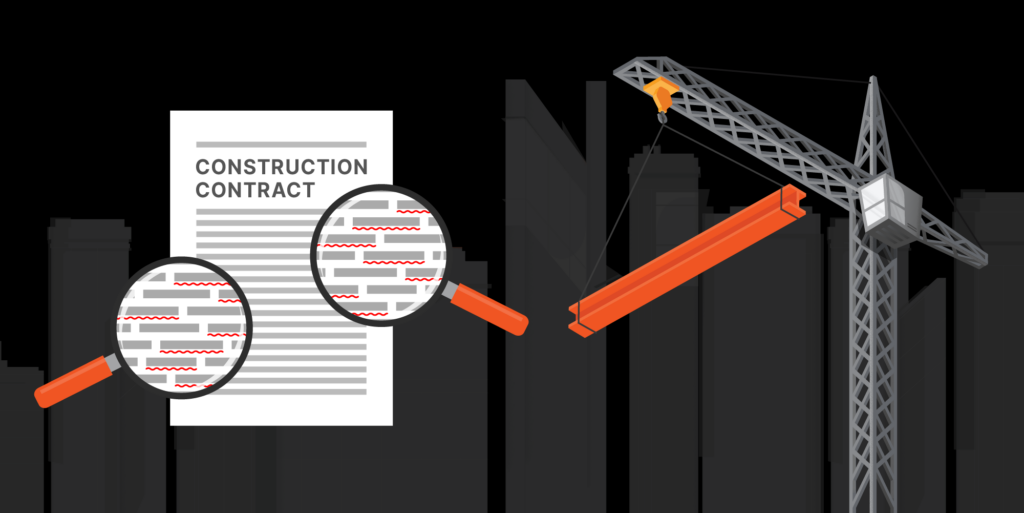— 9 min read
Time and Materials (T&M) Contracts in Construction: Guide for Contractors & Project Owners
Last Updated Jun 11, 2024

A time and materials (T&M) contract is a construction agreement where the project owner pays the contractor for all material and labor costs on a project as well as contractor markup. Unlike lump sum contracts, a T&M contract is based on the actual time spent and materials used on a project rather than a fixed fee. This type of construction agreement is often used in cases where the scope of work or project duration is uncertain — or where changes are likely to occur during the project. With projects that have unknowns, T&M contracts provide greater flexibility and transparency for both the owner and the contractor.
Read on to learn more about how T&M contracts work as well as the advantages and disadvantages of these contracts for contractors and project owners.
Table of contents
How time and materials contracts work
A time and materials contract is an agreement where contractors are reimbursed for materials used and hours billed on a project including a negotiated markup. Essentially, the basis of the contractor’s bid includes the unit costs of materials, an hourly or daily rate, and contractor markup.
However, T&M contracts do not provide an unlimited budget for a project. While T&M contracts are based on the actual time and materials used for a project, the client and contractor usually establish an estimate for the project based on the known scope of work when the project commences. Sometimes, the contract will include a maximum limit (a “not-to-exceed” clause) on the amount that the client is willing to pay for the project. This clause limits the client’s financial liability, provides clarity on the overall project cost, and serves as a guideline for the contractor to manage costs, ensuring that the project is completed within the client's specific budget.
| What’s covered in a T&M contract? | |
| Materials Costs | Materials costs associated with the construction project, including the actual cost of materials (including freight), taxes, and a specified markup — typically between 10% and 30%. |
| Labor Costs | Labor costs associated with the construction project. Usually defined as a fixed hourly or daily rate, also called loaded labor rate, which includes base wages, overhead, indirect costs, and a profit markup. |
T&M contracts are commonly established between a project owner and general contractor when a project’s scope of work is not well defined or when the project duration is unknown. This contract type can also be used between general contractors and specialty contractors depending on the project parameters and goals.
Using the known scope of work, the contractor will do the following:
- Determine loaded labor rates, which include wages, overhead and administrative costs, and profit markup.
- Identify and price the materials that will be required for the project, including freight as well as the contractor’s markup.
- Provide an estimate of labor hours and materials needed to complete the work.
T&M contracts are often easier to negotiate as the financial risks are minimized for the contractor. Under a T&M contract, contractors know that their costs will be reimbursed throughout the duration of the entire project. As project conditions change or the scope of work adjusts throughout the course of construction, contractors can provide project owners with updated estimates of the total cost of the project.
Learn more: 5 Main Types of Construction Contracts
Advantages of T&M contracts
T&M contracts offer advantages to both project owners and contractors.
| Advantages of T&M contracts | |
| Owners | Contractors |
| Simplicity Once the labor and material rates are agreed upon, work can often begin quickly, as contractors are less exposed to financial risk than they are with many other contract types. | Straightforward compensation With a T&M contract, the contractor is compensated for all work performed and all costs incurred, including any unforeseen or additional work required to complete the project, resulting in greater financial security. |
| Flexibility Owners can often adjust the scope and direction of the project as it progresses without having to renegotiate the entire contract. | Decreased burden before construction Preconstruction efforts are minimal, reducing the effort required by the contractor prior to construction. |
| Transparency Throughout the project, the contractor provides the owner with detailed information about the costs of the work, enabling the owner to monitor the project's budget and progress. | Opportunity to build long-term relationships The transparency required in a T&M contract can enable contractors to establish a solid relationship with the client that potentially results in future opportunities. |
| Easily compare bids The simple pricing structure — just labor rates and material costs — allows owners to easily compare between bids. | Profitability If markup rates are correctly calculated to cover overhead and profit, contractors are likely to maintain profitability on a T&M project. |
For project owners who are tackling projects with an unpredictable scope of work, a T&M contract generally provides them with the flexibility to handle any unforeseen conditions that arise. For contractors, profitability is much more likely as they are compensated for all the time and materials used regardless of unknowns.
Explore data and trends for building materials prices.
Get the latest U.S. retail prices and view historical trends for common building materials.
Disadvantages of T&M contracts
Although a T&M contract offers many advantages, there are also drawbacks for both parties involved. These can be minimized by establishing a well-structured contract, building on a solid relationship, and prioritizing communication and transparency.
| Disadvantages of T&M contracts | |
| Owners | Contractors |
| No established budget Due to the uncertainty of the scope, there is no established budget, which opens up the owner to greater financial risk. | Requires detailed cost tracking In order to get compensated, the contractor must provide a detailed breakdown of all costs incurred throughout the project, requiring a sophisticated cost-tracking system. |
| Requires a trusted partner Without a trusted partner, owners may worry that the contractor is stretching the project out to increase their costs unnecessarily. | Upfront financial burden Specialty contractors using T&M contracts can struggle with cash flow issues as they bear the upfront labor, material, and overhead costs until they are reimbursed by someone higher on the payment chain. |
| Offers no incentives for efficiency As a contractor is compensated for the number of hours worked, they are less incentivized to work efficiently. | Difficulty managing client expectations Due to the undefined nature of the project’s scope, it’s difficult for the contractor to initially provide accurate estimates to the owner regarding the overall cost of the project. |
T&M contracts are often established between parties that have an existing relationship. The owner is more comfortable selecting a contractor they know won’t drag the project out unnecessarily to try to earn additional revenue.
Potential solutions to mitigating the pitfalls of a T&M contract include the following:
- Building on an established relationship: T&M contracts are often the most efficient and deliver the best results when there is trust between both parties. The contractor is able to quickly and efficiently tackle problems onsite while the owner is assured that the contractor isn’t cutting corners or inflating hours in order to increase earnings.
- Adding in a “not-to-exceed” (NTE) clause: Incorporating an NTE clause into the contract decreases the owner’s risk and provides them with greater financial certainty. For the contractor, this removes the burden of managing the client’s expectations around budget because the cost is capped, like a GMP or lump sum contract.
- Establishing clear communication: Maintaining open and clear communication throughout the project can help prevent any potential issues from escalating into larger problems.
T&M contract example
A large retail company approaches Finley Construction, a general contractor, to ask them to renovate a store that was recently damaged by a storm. The project owner is looking to quickly get a contractor onsite, and assess what work needs to be done for the store to be operational again.
Due to the uncertainty of the scope and project duration, the owner decides to use a T&M contract in order to make negotiations easier and get construction started. The two parties have worked together previously and have an established solid relationship.
Finley Construction calculates its loaded labor rates including wages, overhead, and markup as well as unit prices for required materials. They submit this pricing information to the project owner. Eventually, Finley Construction and the owner negotiate and sign the contract, which includes standard terms around payments, change orders, dispute resolution, and more. While a T&M contract can put the owner at greater financial risk, the trust between the two parties mitigates the owner’s concerns.
Finley Construction quickly mobilizes onsite, brings trusted subcontractors on board, and begins work on the project. Based on their contractual payment schedule, Finley Construction submits invoices to the owner monthly, detailing the hours worked and the materials used. The project owner reviews the invoices and pays Finley Construction according to the agreed-upon schedule, and Finley Construction pays its specialty contractors in turn. These invoices serve as a cost update for the owner, enabling them to cross-check the progress with the budget.
During construction, Finley Construction realizes that the storm caused extensive water intrusion and damage to the store which will need significant remediation. With the flexibility of the T&M contract, they can inform the owner, clarify the additional scope, and quickly adapt to resolve the issue.
Once construction is complete, Finley Construction compiles all documentation related to the project, including invoices, receipts, and timesheets. The contractor passes this documentation on to the owner along with a final invoice that outlines the total cost of the project. The owner conducts a final inspection and approves payment to Finley Construction.
In this instance, a T&M contract was the perfect solution that balanced both parties' priorities. The owner was looking to quickly tackle a project with an undefined scope and unclear duration. Due to the nature of their relationship, they were able to quickly bring Finley Construction onboard. Under a T&M contract, the general contractor is likely to turn a profit as long as they’ve correctly calculated their loaded labor rate and material costs.
With a T&M contract, Finley Construction was able to quickly mobilize onsite, handling a tricky construction project with an unclear scope. The partnership between the owner and the contractor yielded a prompt and seamless delivery of a high-quality project.
Contract formation determines success
Understanding the ins and outs of each contract type can significantly impact the success of a project for both owners and contractors. Contract formation presents an opportunity for both parties to mitigate risks and ensure their top priorities are realized.
A well-defined T&M contract can promote clear and effective communication between the owner and contractor, afford the team the ability to adapt to any unforeseen issues that may arise, and ultimately deliver a high-quality construction project amidst the chaos of unknown or undefined conditions.
Was this article helpful?
Thank you for your submission.
91%
9%
You voted that this article was . Was this a mistake? If so, change your vote here.
Scroll less, learn more about construction.
Subscribe to The Blueprint, Procore’s construction newsletter, to get content from industry experts delivered straight to your inbox.
By clicking this button, you agree to our Privacy Notice and Terms of Service.
Categories:
Tags:
Written by
Noah Soven
Noah is an Account Executive at Procore with a focus on General Contractors. He previously worked as a Project Manager for Williams Company, FORE Construction, and Ashton Woods Homes. His areas of specialty include contract administration, budget forecasting, subcontractor management, and schedule. He lives in Tampa, Florida.
View profileTaylor Riso
80 articles
Taylor Riso is a marketing professional with more than 10 years of experience in the construction industry. Skilled in content development and marketing strategies, she leverages her diverse experience to help professionals in the built environment. She currently resides in Portland, Oregon.
View profileExplore more helpful resources

Understanding Supplementary Conditions on Construction Contracts
No two construction projects are exactly alike — and the same goes for construction contracts. Even when using a standard contract form, owners and contractors sometimes use supplementary conditions to...

A Straightforward Guide to Construction Contract Review
Construction contracts are like the glue for the project team. They’re the ties that bind the working relationships and goals for the project, containing information about responsibilities, liabilities and processes...

Escalation Clauses in Construction Contracts: When and How They Apply
In construction contracts, an escalation clause allows for the escalation of a certain price for labor or materials to be used in a construction project. This type of clause is most...

Scope Gap: Addressing Ambiguous Project Requirements
To turn contract documents into an actual building, every construction project requires stakeholders to complete certain items of work. Ideally, the scope of work outlines those items and clarifies who’s...
Free Tools
Calculators
Use our calculators to estimate the cost of construction materials for your next project.
Templates
Find a template to help you with your construction project tasks.
Material Price Tracker
Get the latest U.S. retail prices and view historical trends for common building materials.
Glossary
Explore key terms and phrases used in the industry.